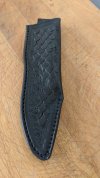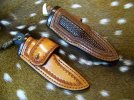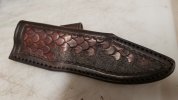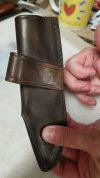- Joined
- Sep 21, 2016
- Messages
- 450
Pleased with the overall outcome of this sheath, but am looking for advice as so how to get more definition on the border around my tooled pattern. (this is something I should probably know, but don't). Should I have used a swivel knife around that area? I didn't want to use a camouflage tool around the border, just wanted a nice deep line.
Thanks for the help.

Thanks for the help.










 12
12

